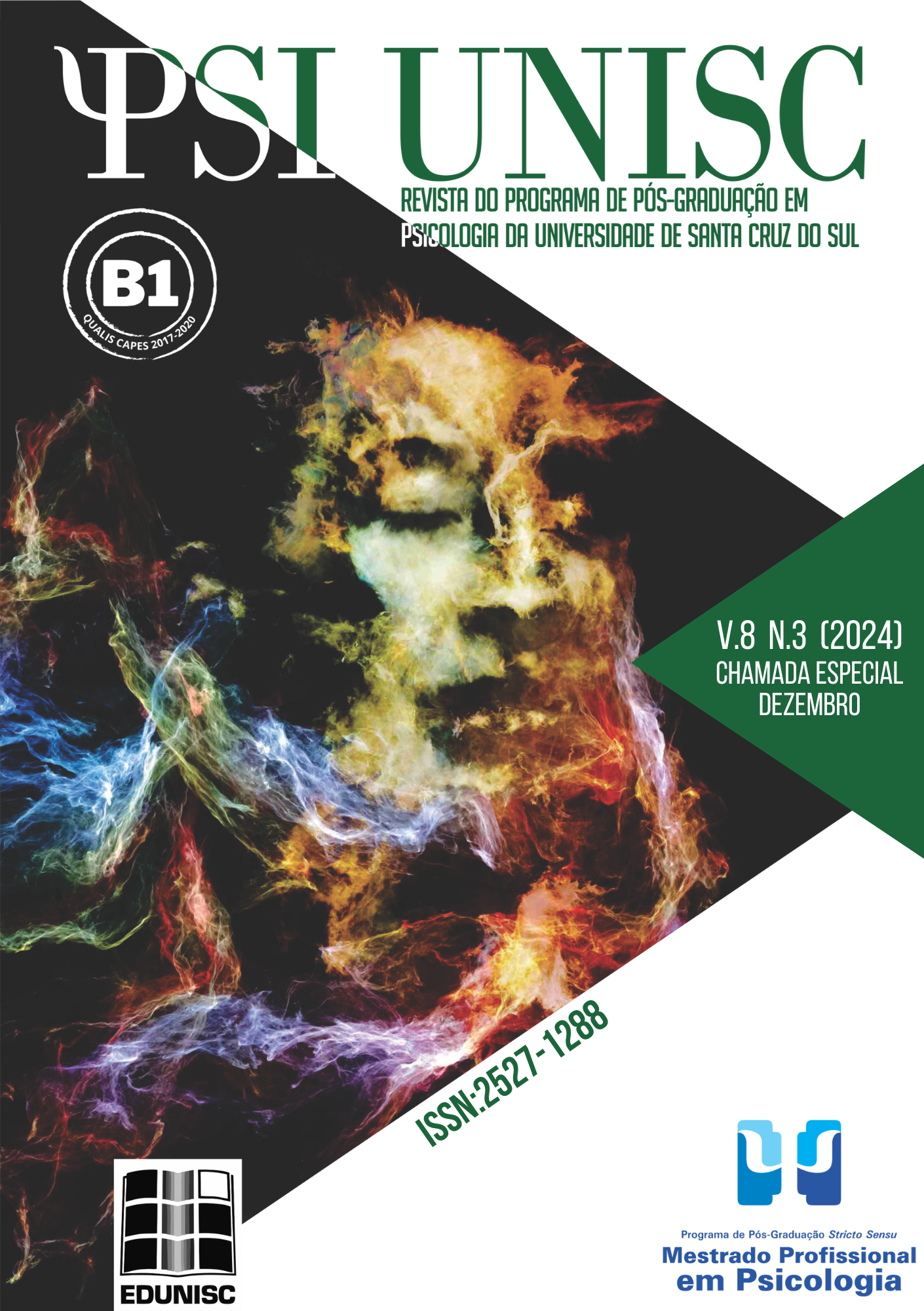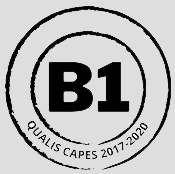Apps to address the covid-19 pandemic in brazil: a systematic review
DOI:
https://doi.org/10.17058/psiunisc.v8i3.18569Keywords:
mhealth, Covid-19, mobile applications, systematic reviewAbstract
The development of applications for mobile devices (apps) is defined as one of the main strategies adopted by governments, health entities and companies in the fight against Covid-19 pandemic. The scientific literature on this technology results and mapping is still not consistent. In this sense, the present research aimed to track the apps that were developed to contribute to the fight against the Covid-19 pandemic in the Brazilian context during the year of 2020 and to analyze their characteristics. The method used was guided by the literature systematic review model, applied in two online stores, Google Play (Android) and Apple Store (IOS). The keywords searched were "Coronavirus", "Covid-19", "SARS-CoV-2" and "social isolation", and we selected 31 apps after the refinement. The results suggest that the number of apps downloads is related to the target audience for which is intendent (general population/health professionals) and their scope (national/regional). The elaborated categories showed that the four main functionalities of the apps are related to information about the virus, user self-assessment, geolocation, and telehealth mechanisms. In addition, it was observed that the main apps developers were public government entities in collaboration with the private sector. It is essential that developers and public managers adopt measures that facilitate user adherence to apps, to enhance the reach of population to digital health.
Downloads
References
Akinbi, A., Forshaw, M., & Blinkhorn, V. (2021). Contact tracing apps for COVID-19 pandemic: challenges and potential. Health Information Science and Systems, 9(1), 1-15. doi: 10.31219/osf.io/6xbcs
Barberia, L. G., & Gómez, E. J. (2020). Political and institutional perils of Brazil's COVID-19 crisis. The Lancet, 396(10248), 367-368. doi: 10.1016/S0140-6736(20)31681-0
Bassi, A., Arfin, S., John, O., & Jha, V. (2020). An overview of mobile applications (apps) to support the coronavirus disease-2019 response in India. The Indian Journal of Medical Research, 15151(5), 468-473. doi: 10.4103/ijmr.IJMR_1200_20
Brasil. (2018). Instituto Brasileiro de Geografia e Estatística. Pesquisa Nacional por Amostra de Domicílios Contínua 2017-2018. Rio de Janeiro, RJ: IBGE.
Brasil (2021). Mnistério da Saúde. Manual do usuário : DigiSUS gestor : módulo planejamento [recurso eletrônico] / Brasília: Ministério da Saúde.
Brasil. (2020). Ministério da Saúde. Painel Coronavírus. Brasília, DF: MS.
Brasil. (2010). Secretaria de Assuntos Estratégicos da Presidência da República. Instituto de Pesquisa Econômica Aplicada. Presença do Estado no Brasil. 2. ed. Brasília, DF: IPEA.
Collado-Borrell, R., Escudero-Vilaplana, V., Villanueva-Bueno, C., Herranz-Alonso, A., & Sanjurjo-Saez, M. (2020). Features and functionalities of smartphone apps related to COVID-19: systematic search in app stores and content analysis. Journal of Medical Internet Research, 22(8), e20334. doi: 10.2196/20334
Ferretti, L., Wymant, C., Kendall, M., Zhao, L., Nurtay, A., Abeler-Dörner, L., … , Fraser, C. (2020). Quantifying SARS-CoV-2 transmission suggests epidemic control with digital contact tracing. Science, 368(6491), eabb6936. doi: 10.1126/science.abb6936
Gillespie, T. (2018). A relevância dos algoritmos. Parágrafo, 6(1), 95-121. https://revistaseletronicas.fiamfaam.br/index.php/recicofi/article/view/722
Guinchard, A. (2020). Our digital footprint under Covid-19: should we fear the UK digital contact tracing app? International Review of Law, Computers & Technology, 35(1), 84-97. doi: 10.1080/13600869.2020.1794569
Ienca, M., & Vayena, E. (2020). On the responsible use of digital data to tackle the COVID-19 pandemic. Nature Medicine, 26(4), 458-464. https://www.nature.com/articles/s41591-020-0832-5
Lana, R. M., Coelho, F. C., Gomes, M. F. C., Cruz, O. G., Bastos, L. S., Villela, D. A. M., & Codeço, C. T. (2020). Emergência do novo coronavírus (SARS-CoV-2) e o papel de uma vigilância nacional em saúde oportuna e efetiva. Cadernos de Saúde Pública, 36(3), e00019620. doi: 10.1590/0102-311X00019620
Magno, L., Rossi, T. A., Mendonça-Lima, F. W., Santos, C. C., Campos, G. B., Marques, L. M., ... , Dourado, I. (2020). Desafios e propostas para ampliação da testagem e diagnóstico para COVID-19 no Brasil. Ciência & Saúde Coletiva, 25(9), 3355-3364. doi: 10.1590/1413-81232020259.17812020
Maldonado, J. M. S. V., Marques, A. B., & Cruz, A. (2016). Telemedicina: desafios à saúde no Brasil. Cadernos de Saúde Pública, Rio de Janeiro, v. 32, n. 2, p. e00155615. doi: 10.1590/0102-311X00155615
Meirelles, F. S. (2023). Pesquisa Anual do FGVcia da FGV-EAESP - Uso de Tecnologia de Informação nas Empresas. 34. ed. São Paulo, SP: FGV. Recuperado de https://eaesp.fgv.br/sites/eaesp.fgv.br/files/u68/pesti-fgvcia-2023_0.pdf
Ming, L. C., Untong, N., Aliudin, N. A., Osili, N., Kifli, N., Tan, C. S., … , Goh, H. P. (2020). Mobile health apps on COVID-19 launched in the early days of the pandemic: content analysis and review. JMIR mHealth and uHealth, 8(9), e19796. doi: 10.2196/19796
Moura, L., & Camargo, G. (2019). Impacto econômico e social do Android no Brasil. São Paulo, SP: Bain & Company. Recuperado de https://www.bain.com/contentassets/a9200a057a0241b8963c05a9b09e33fe/impactos-do-android-no-brasil.pdf
Nichiata, L. Y. I., & Passaro, T. (2023). mHealth e saúde pública: a presença digital do Sistema Único de Saúde do Brasil por meio de aplicativos de dispositivos móveis. Revista Eletrônica De Comunicação, Informação & Inovação Em Saúde, 17(3). https://doi.org/10.29397/reciis.v17i3.3663
Nicholas, J., Larsen, M. E., Proudfoot, J., & Christensen, H. (2015). Mobile apps for bipolar disorder: a systematic review of features and content quality. Journal of Medical Internet Research, 17(8), e198. doi: 10.2196/jmir.4581
Redmiles, E. M. (2020). User concerns 8 tradeoffs in technology-facilitated covid-19 response. Digital Government: Research and Practice, 2(1), 1-12. doi: 10.1145/3428093
Sossai, P., Uguccioni, S., & Casagrande, S. (2020). Telemedicine and the 2019 Coronavirus (SARS‐CoV‐2). International Journal of Clinical Practice, 74(10), e13592. doi: 10.1111/ijcp.13592
Sucala, M., Cuijpers, P., Muench, F., Cardos, R., Soflau, R., Dobrean, A., … , David, D. (2017). Anxiety: there is an app for that. A systematic review of anxiety apps. Depression and Anxiety, 34(6), 518-525. doi: 10.1002/da.22654
Tibes, C. M. S., Dias, J. D., & Zem-Mascarenhas, S. H. (2014). Aplicativos móveis desenvolvidos para a área da saúde no Brasil: revisão integrativa da literatura. Revista Mineira de Enfermagem, 18(2), 471-486. https://cdn.publisher.gn1.link/reme.org.br/pdf/v18n2a16.pdf
Torous, J., Myrick, K. J., Rauseo-Ricupero, N., & Firth, J. (2020). Digital mental health and COVID-19: using technology today to accelerate the curve on access and quality tomorrow. JMIR Mental Health, 7(3), e18848. doi: 10.2196/18848
Vasconcellos-Silva, P. R., & Castiel, L. D. (2020). COVID-19, as fake news e o sono da razão comunicativa gerando monstros: a narrativa dos riscos e os riscos das narrativas. Cadernos de Saúde Pública, 36(7), e00101920. doi: 10.1590/0102-311X00101920
Whitelaw, S., Mamas, A. M., Topol, E., & Spall, H. G. (2020). Applications of digital technology in COVID-19 pandemic planning and response. The Lancet Digital Health, 2(8), e435-e440. doi: 10.1016/S2589-7500(20)30142-4
World Health Organization. (2020). Coronavirus disease (COVID-19). Geneva: WHO. Recuperado de https://www.who.int/health-topics/coronavirus#tab=tab_1
Ybarra, L., & Bull, S. S. (2007). Current trends in Internet-and cell phone-based HIV prevention and intervention programs. Current HIV/AIDS Reports, 4(4), 201-207. https://link.springer.com/article/10.1007/s11904-007-0029-2
Downloads
Published
How to Cite
Issue
Section
License
The submission of originals to this journal implies the transfer, by the authors, of the printed and digital publication rights. The copyrights for the published articles are those of the author, with periodical rights on the first publication. Authors may only use the same results in other publications clearly indicating this journal as the medium of the original publication. Because we are an open access journal, we allow free use of articles in educational and scientific applications provided the source is cited under the Creative Commons CC-BY license.




